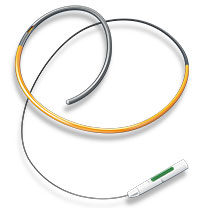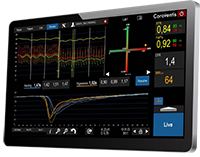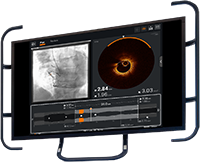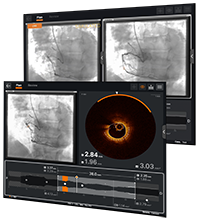Go Beyond the Angiogram with Abbott's Coronary Physiology Portfolio
Physiological measurements such as fractional flow reserve (FFR) and resting full-cycle ratio (RFR) can be used to evaluate the functional significance of coronary stenosis.1,2
Beyond the visibility of angiography, index of microcirculatory resistance (IMR) and coronary flow reserve (CFR) can be used to diagnose coronary microvascular dysfunction (CMD).3,4
A full physiology assessment can help determine an accurate diagnosis to improve patient outcomes and enhance quality of life.3-6
PressureWire™ X Guidewire
The innovative PressureWire™ X Guidewire—the world’s only1,7 full physiology wire can measure pressure and temperature to calculate Abbott's RFR, FFR, IMR, and CFR. The guidewire’s fully integrated, secure, wireless measurements are integral to a cardiac cath lab’s clinical physiology routine.1

CoroFlow‡ Cardiovascular System
The CoroFlow‡ Cardiovascular System is an advanced platform to measure physiological indices: FFR and RFR to assess epicardial vessels; plus CFR and IMR to assess microcirculation. This system is designed specifically to communicate with the wireless PressureWire™ X Guidewire.1,8

OPTIS™ Next Imaging Systems
The OPTIS™ Next Imaging Systems offer wireless physiology (FFR and RFR) and optical coherence tomography (OCT) with seamless integration into the cath lab and PCI workflow.9

Ultreon™ Software
Ultreon™ Software is the next-generation imaging and physiology software. Streamlined and intuitive, Ultreon™ Software gives better insights to optimize patient outcomes through automation and improved workflow.10-13




References
- PressureWire™ X Guidewire Instructions for Use (IFU). Refer to IFU for additional information.
- Svanerud J, et al. Validation of a novel non-hyperaemic index of coronary artery stenosis severity: the Resting Full-cycle Ratio (VALIDATE RFR) study. EuroIntervention. 2018;14:806-814.
- Ford T, et al. CorMicA Trial. 2018; 72(23): 2841-55 with online appendix.
- Kunadian V, et al. EAPCI Expert Consensus Document on Ischaemia with Non-Obstructive Coronary Arteries. EHJ. 2020; 0, 1-21.
- Tonino PA, et al. Angiographics versus functional severity of coronary artery stenoses in the FAME study: Fractional flow reserve versus angiography in multivessel evaluation. J Am Coll Cardiol 2010; 55:2816-21.
- De Bruyne B, et al. FFR Guided PCI versus Medical Therapy in Stable Coronary Disease, NEJM. 2012; 367 (11): 991-1001.
- Volcano Corp. Verrata‡ guidewire and PrimeWire Prestige‡ Plus guidewire IFUs, Opsens Inc. OptoWire‡ guidewire and OptoWire‡ II guidewire IFUS, ACIST Medical Systems. Navvus‡ Microcatheter IFU, Boston Scientific Corporation. Comet‡ guidewire IFU.
- CoroFlow‡ Cardiovascular System Instructions for Use (IFU). Refer to IFU for additional information.
- OPTIS™ Next Imaging Systems Instructions for Use (IFU). Refer to IFU for additional information.
- Ultreon™ 2.0 Software Instructions for Use (IFU). Ultreon™ 1.0 Software IFU. Refer to IFUs for additional information. Data on file at Abbott.
- Zhang J, et al. Intravascular ultrasound versus angiography-guided drug-eluting stent implantation: the ULTIMATE trial. J Am Coll Cardiol. 2018;72(24):3126-3137.
- Hong M, et al. IVUS-XPL 5 Year Outcomes. TCT 2019.
- Angiography Alone Versus Angiography Plus Optical Coherence Tomography to Guide Percutaneous Coronary Intervention – Outcomes From the Pan-London PCI Cohort. Jones et al. JACC Cardiovascular Interventions, 2018, vol 11 (14).
MAT-2104372 v3.0
